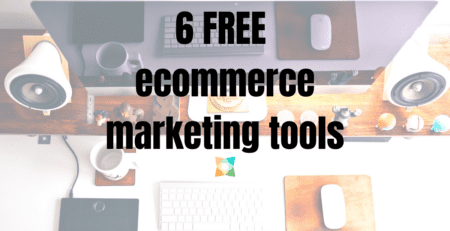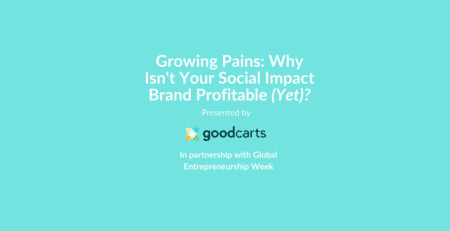There’s no missing the fact that cause marketing is having something of a moment. More and more brands are positioning themselves firmly in the sustainable, ethical camp in how they present their values and ethos to the paying public.
What’s fueling this uptick in “for good” brands? Conscious consumerism has been on the increase for a number of years now. The rise of ecommerce and social media has ensured that the average shopper is better informed and more willing to investigate the underpinning impact of the items that they buy. The wake-up call provided by the recent pandemic has further fanned the flames of this expectation. Today, more than ever before, people expect brands to step up and do their part for the greater good.
Listening and responding to this desire can be a profitable approach. Increasingly shoppers are engaging (knowingly or otherwise) in the practice of “buycotting”. This is a phenomenon whereby people support brands that align with their values, staying loyal to those who are “doing good” and shunning brands who behave in a way that contradicts their own ethics.
Nailing your colors to the mast with a strong cause marketing focus represents a high risk/high reward strategy. If you can approach cause marketing and eco position with real transparency and genuine credentials, you stand to be very successful. But get this wrong, and things can unravel very quickly – and the public backlash can be merciless!
Use this article to learn about and successfully navigate the fine line between true cause marketing and greenwashing.
What is Greenwashing?
While the swing towards more sustainable brand positioning may feel like a modern trend, the term ‘greenwashing’ has been with us since the 1980s. First coined by Jay Westerveld, the environmentalist used the term to describe the practice of hotels of encouraging guests to reuse their towels instead of receiving a fresh one each day. Seemingly this was presented as an eco-friendly motivation (i.e. to save resources) but in reality, it usually proved to be more of a cost-cutting exercise.
With eco and ethical brand positioning proving so popular in the modern market, it’s unsurprising that many brands are falling foul of this ill-conceived approach. While in many cases greenwashing may not be willfully deceitful, very few companies are truly thinking through the total impact of their activities in relation to the PR-friendly claims they make.
Greenwashing comes in many forms. From hidden trade-offs (suggesting a product is sustainable based on a handful of carefully selected attributes), unsubstantiated claims and vague allusion to a greener approach without any tangible evidence, through to positioning marginally better products as the “lesser of two evils”, to outright lying – there are many ways in which brands seek to pull the (organic, ethically harvested) wool over our eyes.
A good litmus test to perform when a marketing claim smells of greenwashing? Ask yourself – does it seem as though more has been spent on the marketing campaign than has actually been spent on the advertised action to reduce environmental impact? This will usually give you your answer.
What is Cause Marketing?
At the other end of the spectrum, we find cause marketing. Interestingly, this is another term that had its genesis in the 1980s, commonly attributed to American Express with their campaign that sought to raise funds for the Statue of Liberty.
Cause marketing is the practice of when a business is seeking to raise their profile or increase profits by following corporate social responsibility practices. This might take the form of fundraising for a certain charity, donating products to help a disadvantaged social group, or committing to supporting sustainability initiatives through employee volunteering schemes. Whatever the good deed, cause marketing is the act of centering a campaign around the practice, and promoting the brand’s positive image for gain as a result.
In the modern-day, we’re all much better informed and connected when it comes to doing the right thing. Social media means that we can quickly share and spread a message, and social causes can quickly accelerate in visibility and popular support. When we think of some of the largest and most powerful activism movements of the last few years – #MeToo, #BlackLivesMatter, and the reaction to the devastating Australian wildfires – we can see how quickly brands need to consider their position and react in an appropriate, public manner.
Judge a campaign perfectly, and cause marketing has a lot to offer. From better alignment with the causes and values held by your audience to improved PR and positive media coverage, there’s much to gain. Certain tactics such as donations made for every purchase have also been shown to increase customer loyalty and average order value (AOV). Cause marketing is no silver bullet, however. Brands still need to walk a fine line between boosting their brand’s profile and coming across as truly authentic.
How can you spot a true cause marketing campaign? For a start, there should be a cause involved! Look for concrete donations, tangible impact – there shouldn’t be anything vague or wishy-washy about these campaigns. It’s about real impact, clearly communicated.
The Real Deal: Why Do Brands Need to Know the Difference Between Cause Marketing and Greenwashing?
Unfortunately, as so often happens when brands jump on a bandwagon, the lines between cause marketing and greenwashing are becoming blurred. This is bad for everyone involved. Greenwashing dressed up as cause marketing (much akin to lipstick on a pig!) benefits no one – in fact, everyone involved is disadvantaged.
Brands suffer when they get called out for greenwashing, being subjected to reputational damage, terrible PR, a lack of future trust, and even the loss of previously faithful customers.
Consumers suffer. Their faith in a brand is rocked to the core, and they may now distrust brands they previously respected. As a result, they become more cynical about their ability to make a real difference through their choices.
Saddest of all, deserving causes suffer not only are they missing out on the chance to benefit from genuine assistance but because if public faith in cause marketing is eroded, they’ll also struggle to benefit from genuine campaigns in the future.
A lazy, ill-conceived approach to a marketing campaign that fails to address the real factors necessary to make an actual difference will always do more harm than good. Instead of polishing your halo, your brand may find itself the subject of closer scrutiny, as customers look for proof of your claim. Unless you’re practicing what you preach, you’ll be hauled up for hypocrisy – and word travels fast on social media!
Greenwashed: Brands Who Got It Wrong
Brands regularly come under fire for greenwashing, and certain verticals are more likely to fall foul of public scrutiny. As green marketing is held up for closer and closer examination, the number of brands that find themselves in hot water will continue to rise.
The Walking Contradictions
H&M is a solid example of a huge fashion retailer that is often accused of paying lip service to sustainability. Huge emphasis is placed on the brand’s ‘Conscious Collection’ – but as an enterprise, they remain massive contributors to the fast fashion industry. They’ve also come up against boycotting as they reportedly laid-off garment workers without warning.
The Trend Exploiters
Band-Aid was recently accused of jumping on the “Band-Wagon.” As protests broke out across the world in support of the #BlackLivesMatter movement, the brand reacted by launching a more racially diverse range of “skin tone” band-aids. This response was swiftly called out as pandering to the current public mood – these have been requested for years!
The Overreachers
Some brands simply over-sell or misrepresent their actions. Windex is a good example of this- they marketed bottles as made from “ocean plastic.” Many (perhaps most) would assume that this meant plastic that had been actively removed from the ocean. Instead, it was found to be collected from plastic banks in Haiti, the Philippines and Indonesia; plastic collected on land that would otherwise have had the potential to leak into the ocean… Still recycled, but the environmental upsell of “ocean plastic” is notable.
Cause Celebre: Brands Who Got It Right
While many brands hit a bum note when trying to sell themselves in the greenest or most socially responsible light, it’s important to note that cause marketing isn’t a hopeless cause. When done well, it can prove to be real promotional gold dust. Let’s take a look at a few brands that managed to convey the necessary levels of authenticity.
The Non-Profiteers
Although it must be said that Uber gets its fair share of criticism as a company – their #thankyoufornotridingwithus campaign hit the right notes in the pandemic, and their mission switch to transporting essentials throughout the Covid crisis was very well-judged and communicated.
The Political Rebels
In 2018, UK supermarket Iceland teamed up with Greenpeace to launch an emotive Christmas advertising campaign, centered around their pledge to remove palm oil from their “own brand” food range. Ironically, when the advert was banned for being “too political” this gave their cause a huge promotional boost. The ad went viral and was viewed more than 65 million times on social media.
The Veterans
Certain brands have been running cause-related campaigns for so long that they’ve become all but synonymous with each other. Starbucks and RED teamed up over ten years ago to help fight Aids, and the partnership is very well received and respected.
Your Strategy: Genuine Values vs. PR Stunts
So, how can (and should) you approach your own cause marketing efforts to maximize your chances of running a successful and well-received campaign?
Two factors above all else are critically important. Firstly, full transparency. Be absolutely clear about the action you are taking and the results that you hope to achieve. If you’re donating money – how much? If you’re donating goods or services, in what quantities or over what length of time. Make your campaign detailed, honest, and totally upfront. Don’t give people a chance to pick holes in any vague claims you make. Secondly, be sure to work with a tangible, well-defined cause.
The next thing to remember – focus on the impact of your work, not the impact of your marketing campaign. Pour your efforts into making a real difference, smashing your fundraising target, helping the greatest number of people possible. Get it right, and the messaging will look after itself – your genuine passion will carry into your campaign.
Plan for the long term – show commitment (remember Starbucks with their decade-long allegiance to RED…) Don’t bounce around from one trendy cause to another, based on which hashtags are popular at the time. Choose a cause that aligns with your audience and their values to find a good and long-lasting fit for your brand.
How to Clearly Communicate Your Good Intentions
Doing good for doing good’s sake is admirable. But unless you’re publically communicating the work you’ve undertaken, you’re not running partaking in cause marketing. Messaging is incredibly important throughout all of this, and how to judge the tone of your campaign messaging is one of the most crucial factors to get right.
One of the best ways to ensure success in this field is to really communicate with your supported cause. See if they’d be happy to be involved in your messaging campaigns, and give them a platform to collaborate with you.
Look for ways to show that your concern for your supported cause is more than skin deep. Seek ways to reflect your values across various brand touchpoints and your website. Show the tangible impact that you’re having, and tell human stories wherever possible. Not only will you be encouraging new customers to support you, and existing ones to stay loyal, you’ll also be acting as a trailblazer for other brands to step up and do more for the greater good themselves.
Don’t Get Greenwashed Away…
Don’t let the fear of greenwashing accusations put you off doing the right (or better) thing. There are so many benefits to getting cause marketing right – and the amazing force for good that cause marketing can represent.
In a recent sweep of 500 websites, the International Consumer Protection Enforcement Network (ICPEN) discovered that 40% of green marketing claims made online could be seen as misleading to consumers. This simply isn’t good enough when there’s so much to be gained – by everyone – when we cause marketing is truly done well.
As we all know, promoting your brand in today’s crowded ecommerce space can feel challenging. Cause marketing can help give your business real purpose, drive, and yes, additional reach.
If you’re looking to double down on your positive impact, GoodCarts offers an additional (free!) method for getting your brand in front of a well-targeted audience that will be highly receptive to deeply authentic good for the world products. Why not increase the benefits of your next cause marketing campaign with an appealing first time customer offer, promoted freely to an aligned and receptive segment of shoppers? As we like to say in jest, save the world for 25% off.
Benefit from GoodCarts free cross-promotional platform today.











